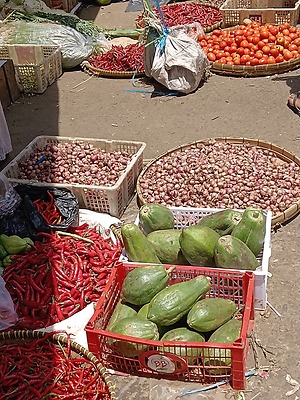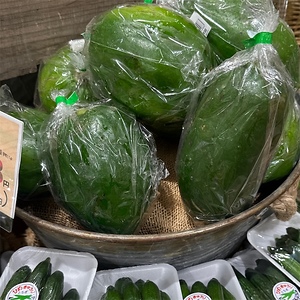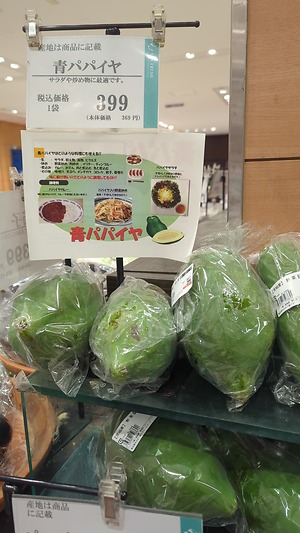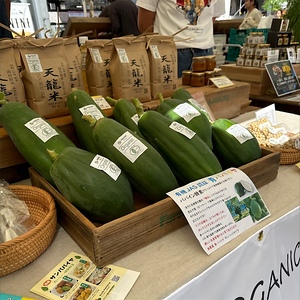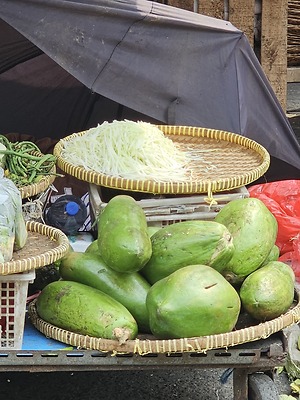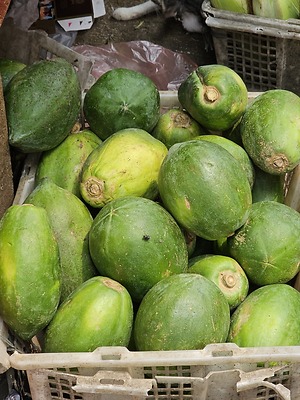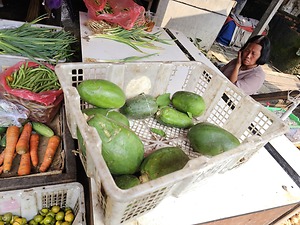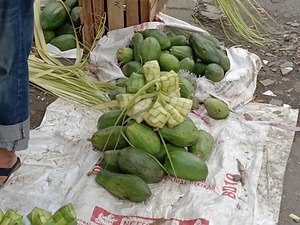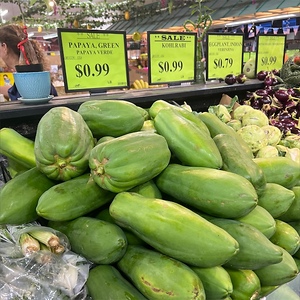

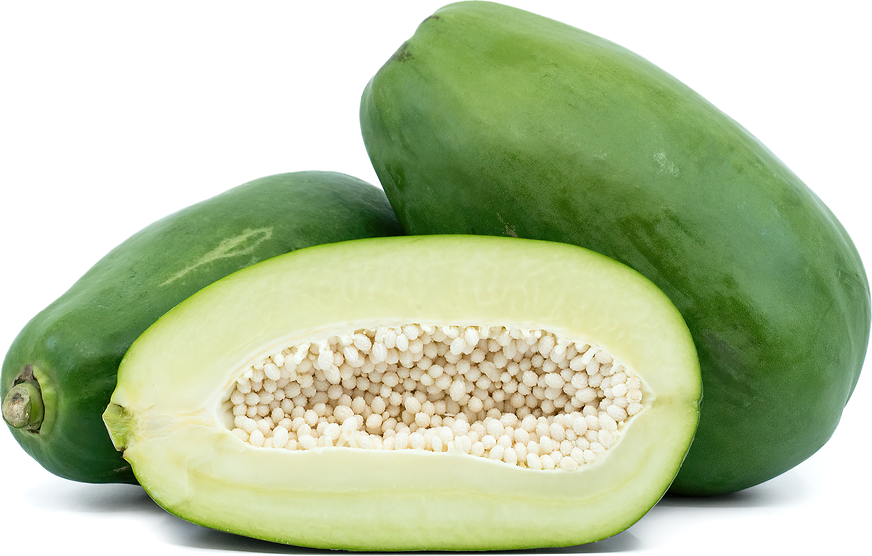
Green Papayas
Estimated Inventory, 35 lbs : 5.58
This item was last sold on : 07/17/25
Description/Taste
Green papayas vary in size, depending on the variety and age at harvest, and generally have an elongated, cylindrical, to pyriform shape with blunt, curved ends and a straight middle. Papayas average 15 to 45 centimeters in length and 10 to 30 centimeters in diameter, and when young, the skin exhibits shades of dusty green to dark green. The skin is thin, smooth, taut, and waxy with a faint sheen. If left to ripen, the green shades will eventually transition into yellow or orange hues. Underneath the surface, Green papayas showcase a white-green flesh with a central cavity filled with white round to oval seeds. The flesh is firm, dense, lightly aqueous, and crunchy, with a crisp, almost carrot-like consistency. Similarly to the skin, if the flesh is allowed to ripen, it will become darker and turn shades of yellow, sometimes red-orange, and the seeds will grow black and hard. Green papayas are young and unripe, releasing a mild, earthy, and woody scent. The unripe flesh is edible raw and has a clean, green, vegetal, tangy, and slightly bitter taste, while the seeds offer a mildly peppery taste. Once cooked, the flesh softens, and the flavor mellows, often absorbing accompanying tastes.
Seasons/Availability
Green papayas are available year-round.
Current Facts
Green papayas, botanically classified as Carica papaya, are unripe fruits utilized for culinary and medicinal preparations belonging to the Caricaceae family. Papayas develop on fast-growing, upright, tree-like plants reaching around 3 to 4 meters in height, and the fruits are attached at the top of the plant by woody tissue on the trunk. There are two main types of papayas, known as Mexican papaya and Hawaiian papaya, both belonging to the same species. Papayas, in general, are also known as Paw Paws in Australia and Asia, mostly referring to yellow-fleshed varieties. It is common to see Green papayas listed as Green Paw Paws in Australian markets. Mexican papaya is typically larger than Hawaiian papayas and has a milder flavor. Depending on the region, Hawaiian papayas are often the choice type for retail sale in commercial markets. Green papayas are harvested from both types and are the unripe versions of the fruit. Historically, Green papayas were harvested in their native growing regions for medicinal uses and, as a culinary ingredient, favored for their firm, crunchy nature, and mild, tangy flavoring. This tradition has expanded to regions worldwide in the modern day, and Green papayas are now a widespread culinary ingredient. The unripe fruits are treated like vegetables in culinary preparations and are utilized raw or cooked in a wide array of sweet or savory preparations.
Nutritional Value
Green papayas are a source of potassium to balance fluid levels in the body, magnesium to control nerve functions, vitamin C to strengthen the immune system, and fiber to regulate the digestive tract. The fruits also provide iron to develop the protein hemoglobin for oxygen transport through the bloodstream, calcium to protect bones and teeth, vitamin A to maintain healthy organs, vitamin E to guard the cells against free radical damage, and other nutrients, including phosphorus, zinc, copper, folate, and vitamin K. In natural medicines, Green papayas are viewed to have anti-inflammatory, antifungal, and detoxifying properties. The fruits are also said to contain five enzymes, one notably being papain, that help improve digestion.
Applications
Green papayas have a mild, clean, green, and vegetal taste suited for fresh and cooked preparations. It is recommended to wash the fruit's exterior, slice one end, and place the fruit on the cut end to help drain the latex. This latex is a sticky white liquid secreted from the skin when cut. Some chefs also wipe the latex off the fruit when peeling or slicing. Once cleaned and prepped, Green papayas can be sliced and consumed as a stand-alone snack, often sprinkled in lime juice, salt, and pepper or coated in tajin. The firm-fleshed fruits can also be shredded into salads and slaws, chopped into salsa, or thinly sliced and incorporated into spring rolls. Once shredded, Green papayas are tossed with sweet and sour dressings to create a crunchy, bright dish, and these mixtures can be added to noodle dishes and rice. The fruits can also be used to tenderize meat, sliced as a topping over tacos, incorporated into various relishes and chutney, or pickled as a tangy condiment. In addition to fresh preparations, Green papayas are cooked in sweet or savory recipes. The fruits can be grilled, stewed, stir-fried, or cut into strips and fried. They are also simmered into stews, curries, and soups or cooked with various meats. The seeds can be dried, ground into a powder, and used as a peppery spice. Green papayas pair well with herbs such as basil, cilantro, and mint, aromatics including garlic, ginger, onions, and chile peppers, spices such as turmeric, cinnamon, and curry, and meats such as pork, beef, and poultry. Whole, unwashed Green Papayas will keep for 1 to 2 weeks when stored in a plastic bag in the refrigerator. Some consumers wrap a paper towel around the fruits to absorb excess moisture.
Ethnic/Cultural Info
Green papayas are famously used in the Thai salad known as Som Tum or Som Tam. The raw dish is seen throughout Thailand in restaurants, through street vendors, and in home kitchens, and it is customary for the salad to be tossed and prepared fresh when ordered. There are many variations of Som Tam using different ingredients, flavorings, and spice levels, but in general, the salad is made from shredded Green papaya, garlic, sugar, peanuts, chiles, limes, beans, tomatoes, carrots, dried shrimp, and fish sauce. Green papayas add a crunchy, crisp, and refreshing nature to the dish. Despite its popularity in Thailand, Som Tam is said to have origins in Thailand’s neighboring country of Laos and was originally called tam maak hung. The Laos version of this dish is typically more savory and less sweet. As the dish spread throughout Laos, it was carried into Thailand and was introduced into the Isan region, where it became known as tam bak hoong, meaning “pounded papaya.” The papaya-centric dish is still widely popular in the Isan region in the present day, and migrant workers eventually carried it into Bangkok, where the salad became known as Som Tam, meaning “pounded sour.” Select street vendors in Thailand solely make Som Tam as a specialty dish using a mortar and pestle, and the refreshing, sweet, spicy, and tangy salad is traditionally served with sticky rice to absorb the flavorful dressing.
Geography/History
Green papayas are native to the Americas and are descendants of wild species that have been naturally growing since ancient times. The center of origin for the wild species is thought to have been in the lowlands of Eastern Central America, spanning from Mexico to Panama. Over time, multiple species were hypothesized to have been hybridized, and indigenous populations in Mesoamerica first domesticated the species. Seeds of the species could be stored for several years once dried, and these seeds were eventually carried from the Americas to the Caribbean, Europe, and Southeast Asia by Spanish and Portuguese explorers around the 16th century. Early papaya species were being grown in India by the 17th century and spread to regions of Africa, Australia, and the South Pacific in the 19th century. Green papayas have been harvested from wild and cultivated trees for centuries. The practice of utilizing unripe fruits in culinary and medicinal preparations has expanded to communities growing the species worldwide and it is common for Green papayas to be seen in raw or cooked dishes near its cultivation region. Green papayas are also exported to markets worldwide as their firm nature allows them to be easily transported. Today, Green papayas are commercially grown in tropical to warm, subtropical climates and are sold in fresh markets, supermarkets, and through distributors.
Featured Restaurants
Restaurants currently purchasing this product as an ingredient for their menu.
| Rosewood Social | San Juan Capistrano CA | 669-243-8403 |
| Palmys | San Diego CA | 858-886-7111 |
| Animae | San Diego CA | 619-925-7908 |
| C 2 C | San Diego CA | 619-972-9345 |
| Dija Mara | Oceanside CA | 760-231-5376 |
| Gravity Heights Restaurant and Brewery | San Diego CA | 858-551-5105 |
| Sovereign Thai Cuisine | San Diego CA | 619-887-2000 |
| Barleymash | San Diego CA | 619-255-7373 |
| Miguel's Cocina Coronado | Coronado CA | 619-437-4237 |
| Saiko Sushi-Coronado | Coronado CA | 619-435-0868 |
| Portside Pier (Miguels) | San Diego CA | 858-268-1030 |
| Cape Rey Carlsbad, a Hilton Resort | Carlsbad CA | 760-602-0800 |
| The Guild Hotel | San Diego CA | 619-764-5108 |
| Polaris Supreme | San Diego CA | 619-390-7890 |
| Corbeaux Wine & Tea House | Temecula CA | 909-567-6109 |
| Royal Polaris Sportfishing | San Diego CA | 619-226-8030 |
| La Jolla Country Club | San Diego CA | 858-454-9601 |
| The Shores | La Jolla CA | 858-459-8271 |
| Jake's Del Mar | Del Mar CA | 858-755-2002 |
| Kettner Exchange | San Diego CA | 909-915-9877 |
| Pacific Yacht Agents | Los Angeles CA | 808-214-0970 |
| Kingfisher | San Diego CA | 619-861-8074 |
| Rancho Santa Fe Golf Club | Rancho Santa Fe CA | 858-756-1582 |
Recipe Ideas
Recipes that include Green Papayas. One







